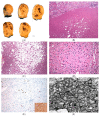ESC, ALK, HOT and LOT: Three Letter Acronyms of Emerging Renal Entities Knocking on the Door of the WHO Classification
- PMID: 31936678
- PMCID: PMC7017067
- DOI: 10.3390/cancers12010168
ESC, ALK, HOT and LOT: Three Letter Acronyms of Emerging Renal Entities Knocking on the Door of the WHO Classification
Abstract
Kidney neoplasms are among the most heterogeneous and diverse tumors. Continuous advancement of this field is reflected in the emergence of new tumour entities and an increased recognition of the expanding morphologic, immunohistochemical, molecular, epidemiologic and clinical spectrum of renal tumors. Most recent advances after the 2016 World Health Organization (WHO) classification of renal cell tumors have provided new evidence on some emerging entities, such as anaplastic lymphoma kinase rearrangement-associated RCC (ALK-RCC), which has already been included in the WHO 2016 classification as a provisional entity. Additionally, several previously unrecognized entities, not currently included in the WHO classification, have also been introduced, such as eosinophilic solid and cystic renal cell carcinoma (ESC RCC), low-grade oncocytic renal tumor (LOT) and high-grade oncocytic renal tumor (HOT) of kidney. Although pathologists play a crucial role in the recognition and classification of these new tumor entities and are at the forefront of the efforts to characterize them, the awareness and the acceptance of these entities among clinicians will ultimately translate into more nuanced management and improved prognostication for individual patients. In this review, we summarise the current knowledge and the novel data on these emerging renal entities, with an aim to promote their increased diagnostic recognition and better characterization, and to facilitate further studies that will hopefully lead to their formal recognition and consideration in the future classifications of kidney tumors.
Keywords: ALK; ESC; HOT; LOT; anaplastic lymphoma kinase rearrangement; emerging entity; kidney; new entity; oncocytic renal tumor; unclassified renal cell carcinoma; unclassified renal tumor.
Conflict of interest statement
The authors declare no conflict of interest.
Figures





References
-
- Trpkov K., Hes O., Bonert M., Lopez J.I., Bonsib S.M., Nesi G., Comperat E., Sibony M., Berney D.M., Martinek P., et al. Eosinophilic, solid, and cystic renal cell carcinoma: Clinicopathologic study of 16 unique, sporadic neoplasms occurring in women. Am. J. Surg. Pathol. 2016;40:60–71. doi: 10.1097/PAS.0000000000000508. - DOI - PubMed
-
- Trpkov K., Abou-Ouf H., Hes O., Lopez J.I., Nesi G., Comperat E., Sibony M., Osunkoya A.O., Zhou M., Gokden N., et al. Eosinophilic solid and cystic renal cell carcinoma (ESC RCC): Further morphologic and molecular characterization of ESC RCC as a distinct entity. Am. J. Surg. Pathol. 2017;41:1299–1308. doi: 10.1097/PAS.0000000000000838. - DOI - PubMed
-
- Moch H., Humphrey P.A., Ulbright T.M., Reuter V.E. WHO Classification of Tumours of the Urinary System and Male Genital Organs. 4th ed. International Agency for Research on Cancer; Lyon, France: 2016.
-
- Guo J., Tretiakova M.S., Troxell M.L., Osunkoya A.O., Fadare O., Sangoi A.R., Shen S.S., Lopez-Beltran A., Mehra R., Heider A., et al. Tuberous sclerosis-associated renal cell carcinoma: A clinicopathologic study of 57 separate carcinomas in 18 patients. Am. J. Surg. Pathol. 2014;38:1457–1467. doi: 10.1097/PAS.0000000000000248. - DOI - PubMed
Publication types
LinkOut - more resources
Full Text Sources

